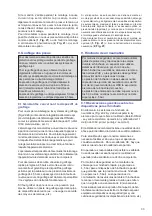
18
9
1
2
10
3. Bead breaking
With the tyre changers a pneumatic tyre bead breaker
is part of the standard equipment.
Please mind the special handling of Run-fl at tires, wheels
with TD rims or rims having an asymmetric hump.
3.1 Bead breaking
Remove the valve insert of the wheel valve.
We would recommend to demount the tyre from the
wide rim shoulder in the fi rst place.
Adjust the chuck so that no component (cylinder,
pneumatic unions, etc.) is in contact with the tyre. If
necessary, move the jaws inside. Lean the defl ated
wheel on the side against the special rubber pads
provided at the machine housing.
Position the bead breaker blade
(Fig. 9, Item 1)
on
the outside of the tyre approximately 1 cm away
from the edge of the rim using the adjustable handle
for accurate positioning.
Depress pedal
(Fig. 9, Item 2).
The blade moves in
between tyre and rim. Release the pedal, continue to
rotate the wheel and repeat the breaking procedure
until the tyre has been unseated completely.
Proceed analogously with the second tyre bead.
In order to facilitate subsequent demounting of tyre
and to preserve tyre and rim, it is most useful to apply
a commercial lubricant on tyre and rim at the place
where the bead breaking blade has just penetrated into
the rim base. Never use other agents only
supposed
to lubricate!
4. Clamping the wheels
•
Before clamping a wheel, release the mounting/
demounting tool (
1, Fig. 10
), move the mounting/
demounting tool to its highest position, push the
mounting arm fully backwards and lock it again.
Depress the pedal (
3, Fig. 10
) to tilt the tower (
2,
Fig. 10
) backwards.
•
Clean the wheel and remove the old balancing
weights.
4.1 Outer clamping of rims
•
Position the wheel (rim)
•
Fully depress the pedal (
1, Fig. 10a
)
then take your
foot off the pedal. The wheel is clamped (
Fig. 11
)
.
•
Depress the pedal past the lower end of stroke
position then release it. The wheel is unclamped.
















































